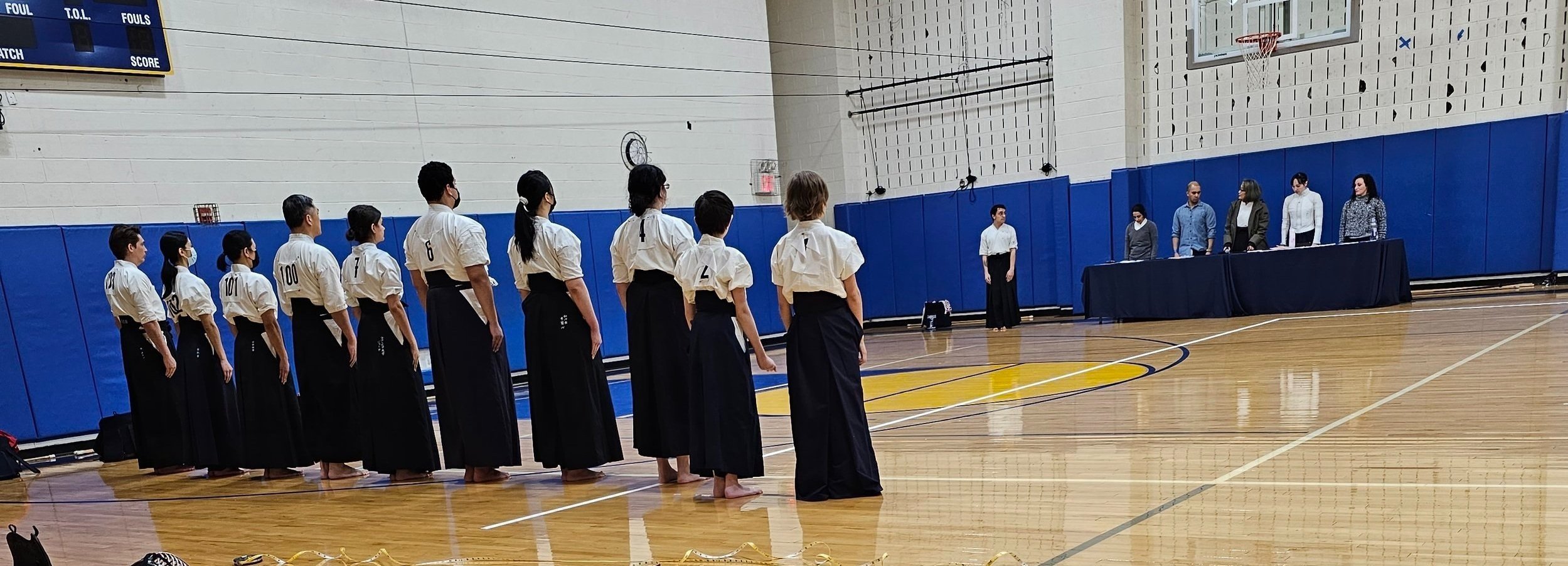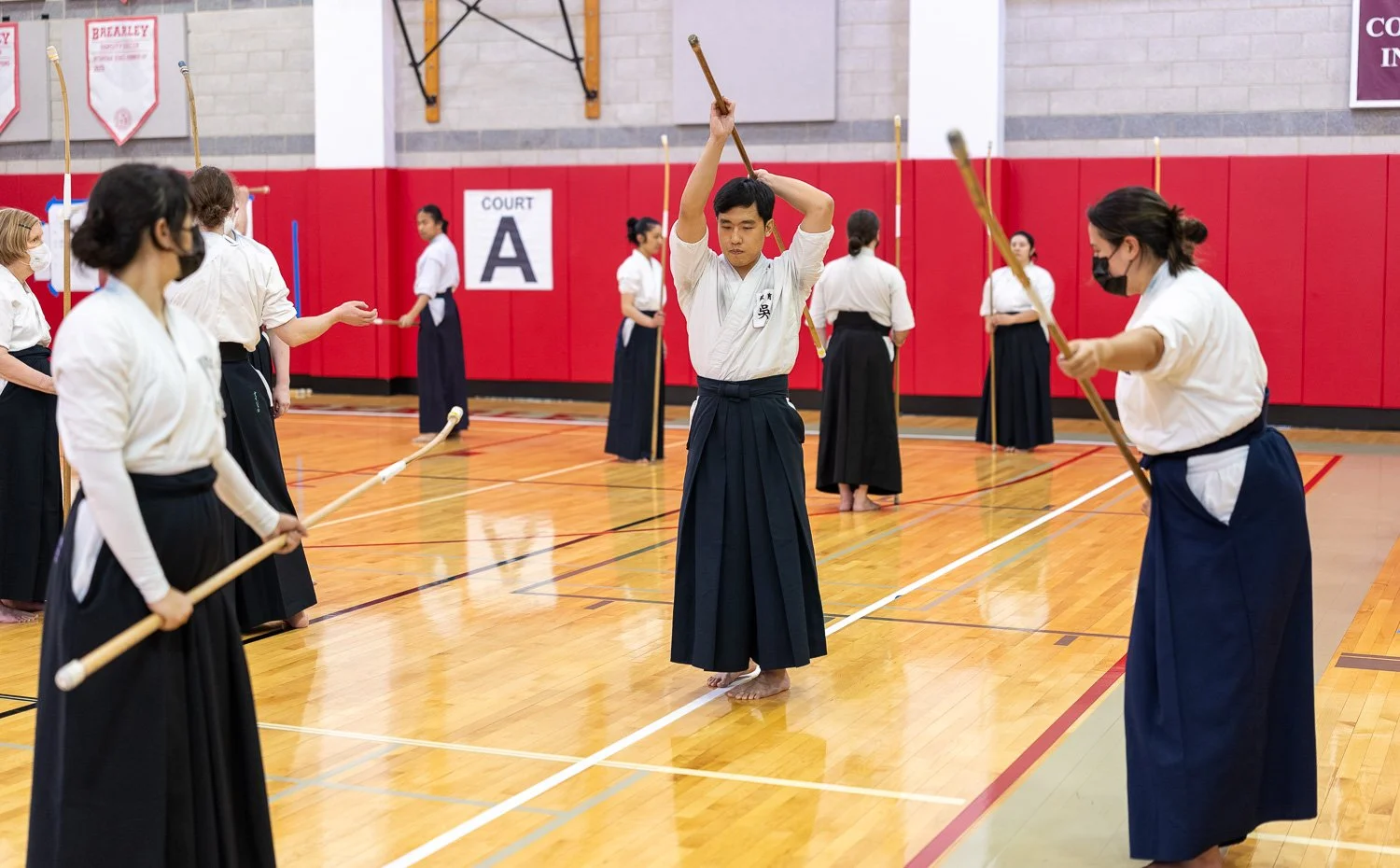
Ranking System in Atarashii Naginata
Like most modern, martial arts systems, (atarashii) naginata also has a ranking system where students can take promotion exams to achieve a rank. Promotion exams are a great way for practitioners to get a sense of where their skills currently stand and to learn the values of goal-making, and hard work. With rank comes privileges, new curricula, and responsibilities to the naginata community.
Students must be recommended by their instructor to take a promotion exam and sign their registration papers.
The kyu ranks are administered by the United States Naginata Federation (USNF), while the dan and shogo ranks are administered by the All Japan Naginata Federation (AJNF). Ranks obtained through both the USNF and AJNF are recognized worldwide.
Kyu Examination Standards (USNF)
Kyu ranks (beginner through intermediate) are administered by the United States Naginata Federation (USNF). Candidates are evaluated on basics (kihon), partner practice (shikake-ōji), and bogu skills as they progress.
Note: All skills are cumulative. Candidates should wear proper naginata uniform (keikogi & hakama). For first-time examinees, uniform may not be required.
| Rank | Requirements | Basics | Shikake-Ōji | Bogu | Waiting Period |
|---|---|---|---|---|---|
| 6-kyu | Recognizes standard commands in Japanese and demonstrates safe techniques with a leader. | Jogeburi; footwork (ashi sabaki); datotsu: men uchi & uke | — | — | — |
| 5-kyu | Performs techniques safely with a partner; demonstrates basic ma-ai in chūdan no kamae. | Jogeburi; datotsu: men uchi & uke; sokumen uchi & uke; sune uchi & uke | 1 & 2 | — | — |
| 4-kyu | Shows introductory consistency in body control, hanmi, footwork, hand positions, and eye contact. | Jogeburi; datotsu: men, sokumen, sune; uchikaeshi | 1 & 2 | — | None |
| 3-kyu | Moderate consistency in body control, kamae, hand positions, footwork, and eye contact; usually reaches target. | Jogeburi; datotsu: men, sokumen, sune; uchikaeshi | 1, 2, & 4 | — | At least 3 months after 4-kyu |
| 2-kyu | Demonstrates consistency in correct hand positions and hanmi; moderate consistency in isshizuki length & hasuji. | Jogeburi; datotsu: men, sokumen, sune, dō; uchikaeshi | 1–5 | — | At least 4 months after 3-kyu |
| 1-kyu | Smooth shikake-ōji and kamae-to-strike transitions; advanced consistency; transfers techniques into bogu. | Jogeburi; datotsu: men, sokumen, sune, dō; uchikaeshi | 1–5 | Uchikaeshi; Kakari Geiko; Gokaku Geiko | At least 6 months after 2-kyu |
Effective: March 11, 2023
Dan Examination Standards (AJNF/INF)
Dan ranks (beginner through intermediate) are administered by the International Naginata Federation (INF)/All Japan Naginata Federation (AJNF). Candidates are evaluated on basics (kihon), partner practice (shikake-ōji), and bogu skills as they progress.
Note: The USNF exams require a bogu section for the 1-dan exam.
| Rank | Grading Basis | Basics | Waza | Match | Lead Practice | Written Exam | Minimum Age | Waiting Period |
|---|---|---|---|---|---|---|---|---|
| 1-dan | People who have mastered basic techniques and how to use them in a match | • Jogeburi • Datotsu: Men, Sokumen, Sune, Dō |
Shikake-Ōji #1–5 • Uchikaeshi • Kakari Geiko • Gokaku Geiko |
No | Yes | Yes | 13 years (Junior High School and up) | At least 6 months after 1-kyu |
| 2-dan | People who can see the chances for striking and have forceful techniques | • Happo buri • Datotsu: Men, Sokumen, Sune, Dō, Kote |
Shikake-Ōji #1–8 • Uchikaeshi • Kakari Geiko • Gokaku Geiko |
No | Yes | Yes | 16 years (High School and up) | At least 1 year after Shodan |
| 3-dan | People who have mastered match methods and can instruct beginners | • Happo buri • All strikes |
Shikake-Ōji #1–8 • Uchikaeshi • Hikitate Geiko • Shiai |
Yes | Yes | Yes | 19 years | At least 2 years after 2-dan |
| 4-dan | People who have mastered advanced techniques, and possess the ability to referee | • Happo buri • All strikes |
Shikake-Ōji #1–8 All Japan Kata #1–5 • Uchikaeshi • Hikitate Geiko • Shiai • Referee* |
Yes | Yes | Yes | 22 years | At least 3 years after 3-dan |
| 5-dan | People who understand the logic of techniques, and who are honest and steadfast | • Happo buri • All strikes |
Shikake-Ōji #1–8 All Japan Kata #1–7 • Uchikaeshi • Hikitate Geiko • Shiai • Referee* |
Yes | Yes | Yes | 25 years | At least 3 years after 4-dan |
* Refereeing in the 4-dan and 5-dan test is not required for candidates already possessing Official Referee Certification.
Effective: April 1, 2013
Source: United States Naginata Federation; 公益財団法人全日本なぎなた連盟, 2017, p. 21
Important Notes on Testing & Advancement
Anniversary dates: The waiting period is based on calendar years, not “365 days.” For example, if you tested for 4-dan on July 1, 2017, and the wait time to 5-dan is 3 years, you would first be eligible on July 1, 2020.
Strict eligibility dates: You cannot test even one day early. If you miss eligibility, your application will be rejected and you’ll need to wait until the next exam opportunity.
Kyu vs. Dan ranks:
Kyu ranks are administered by the USNF (so we follow USNF standards).
Dan ranks are administered by the All Japan Naginata Federation (AJNF) and International Naginata Federation (INF), so we follow their standards.
Menjo (certificate) fees: Each test requires a fee for the official rank certificate.
Keep good records: Every menjo has a unique number. You will need this number to validate your current rank when applying for your next rank..

Guidelines for Taking an Examination
Source: 公益財団法人全日本なぎなた連盟, 2017, p. 20
1. Mental Attitude
There are times when you decide on your own to take an examination in order to test your abilities, and other times when you may be encouraged to take it by your instructor or seniors. In either case, it is important to approach the examination with a sincere and humble attitude.
Before attending the examination, always have your instructor carefully observe your practice and listen to their advice. Calm your mind and give your full effort.
If you pass, strive to demonstrate skill and conduct appropriate to your rank.
If you do not pass, it is essential to understand the reason why. Consult your instructor or seniors, reflect on their feedback, and make every effort to correct your shortcomings. Failure can be an opportunity for growth; it strengthens your resolve and improves your practice.
2. Attire
The keikogi (practice uniform) should be clean, white, and properly fitted to your body. The cords at the chest should be attached on the inside and tied securely.
The keiko-obi (practice belt/sash) should be wrapped twice around the waist, above the hip bones, and tied firmly at the back in either a double or single loop knot.
The keiko-hakama (practice pants-skirt) should have well-defined pleats and be the proper length, ending just above the ankles. The backboard (koshi-ita) should rest on top of the belt, positioned slightly above it.
3. Bogu (Protective Gear) and Equipment
Bogu should be selected to both safely protect the body and allow free movement. Ensure that it fits your body properly and that ties or fastenings do not come undone or loosen during practice.
Before use, check the naginata’s ha-bu (blade section), kissaki (tip), ishizuki (butt end), and sendan-maki (wrapping on the shaft) for any damage or wear.
It is important to always maintain awareness and good habits regarding the inspection and preparation of your clothing, protective gear, and equipment in daily practice.


